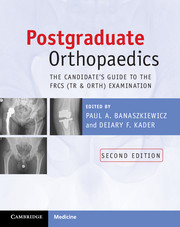Book contents
- Frontmatter
- Contents
- Contributors
- Foreword
- Preface to second edition
- Abbreviations
- Section 1 The FRCS (Tr & Orth) examination
- Section 2 The written paper
- Section 3 The clinicals
- Section 4 The adult elective orthopaedics oral
- Chapter 12 General structured oral exam guidance
- Chapter 13 Shoulder and elbow oral core topics
- Chapter 14 Hip oral core topics
- Chapter 15 Knee oral core topics
- Chapter 16 Foot and ankle oral core topics
- Chapter 17 Spine oral core topics
- Chapter 18 Orthopaedic oncology oral core topics
- Section 5 The hand oral
- Section 6 The paediatric oral
- Section 7 The trauma oral
- Section 8 The basic science oral
- Section 9 Miscellaneous topics
- Index
- References
Chapter 16 - Foot and ankle oral core topics
from Section 4 - The adult elective orthopaedics oral
- Frontmatter
- Contents
- Contributors
- Foreword
- Preface to second edition
- Abbreviations
- Section 1 The FRCS (Tr & Orth) examination
- Section 2 The written paper
- Section 3 The clinicals
- Section 4 The adult elective orthopaedics oral
- Chapter 12 General structured oral exam guidance
- Chapter 13 Shoulder and elbow oral core topics
- Chapter 14 Hip oral core topics
- Chapter 15 Knee oral core topics
- Chapter 16 Foot and ankle oral core topics
- Chapter 17 Spine oral core topics
- Chapter 18 Orthopaedic oncology oral core topics
- Section 5 The hand oral
- Section 6 The paediatric oral
- Section 7 The trauma oral
- Section 8 The basic science oral
- Section 9 Miscellaneous topics
- Index
- References
Summary
Introduction
There is a large recommended syllabus from the British Orthopaedic Foot and Ankle Society for the FRCS (Tr & Orth) examination. This syllabus is very detailed and comprehensive, and if you learned everything on it you would have no time to revise any other subject. Most candidates are not intending to become foot and ankle surgeons. It is difficult to know exactly how much detail is needed to pass the exam.
Whilst a candidate may not be expected to know all the details of every condition, he or she should at least be prepared to answer questions in general on most conditions and in particular on the more common foot and ankle disorders.
- Type
- Chapter
- Information
- Postgraduate OrthopaedicsThe Candidate's Guide to the FRCS (Tr and Orth) Examination, pp. 241 - 262Publisher: Cambridge University PressPrint publication year: 2012



